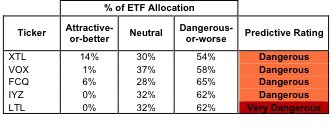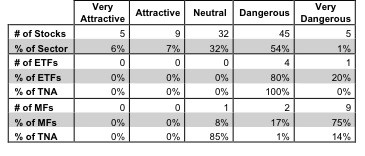The Telecom Services sector ranks ninth out of the ten sectors as detailed in my sector roadmap. It gets my Dangerous rating, which is based on aggregation of ratings of 5 ETFs and 12 mutual funds in the Telecom sector as of April 17, 2012. Reports on the best & worst ETFs and mutual funds in every sector and style are on my blog and Trading Deck.
Figure 1 ranks all five Telecom Services ETFs from best to worst. Figure 2 shows the five best and worst-rated Telecom Services mutual funds.
To identify the best and avoid the worst ETFs and mutual funds within the Telecom sector, investors need a predictive rating based on (1) stocks ratings of the holdings and (2) the all-in expenses of each ETF and mutual fund. Investors need not rely on backward-looking ratings.
The best ETFs and mutual funds allocate more value to Attractive-or-better-rated stocks than the worst, which allocate too much value to Neutral-or-worse-rated stocks.
Investors should not buy any Telecom ETFs or mutual funds because none get an Attractive-or-better rating. If you must have exposure to this sector, you should buy a basket of Attractive-or-better rated stocks and avoid paying undeserved fund fees. Active management has a long history of not paying off.
See ratings and reports on all ETFs and mutual funds in this sector on my free mutual fund and ETF screener.
Figure 2: Mutual Funds with the Best & Worst Ratings – Top 5
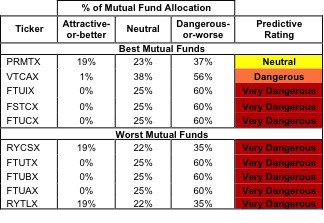 * Best mutual funds exclude funds with TNA’s less than 100 million for inadequate liquidity.
* Best mutual funds exclude funds with TNA’s less than 100 million for inadequate liquidity.
Sources: New Constructs, LLC and company filings
Guggenheim Investments Telecommunications Fund [s: RYMIX] is excluded from Figure 2 because its total net assets (TNA) are below $100 million and do not meet our liquidity standards.
Investors should avoid all Energy ETFs since all five earn a Dangerous-or-worse rating. T Rowe Price Media & Telecommunications Fund, Inc [s: PRMTX] is my top-rated Telecom mutual fund and earns my Neutral rating.
ProShares Ultra Telecommunication ProShares [s: LTL] is my worst-rated Telecom ETF and Guggenheim Investment Telecommunications Fund [s: RYTLX] is my worst-rated Telecom mutual fund. Both earn my Very Dangerous rating.
Figure 3 shows that only 14 out of the 96 stocks (87% of the total net assets) held by Telecom ETFs and mutual funds get an Attractive-or-better rating. This explains why none of the 5 ETFs and 12 mutual funds earn an Attractive-or-better rating. Figure 3 supports my message that the quality of any ETF and mutual fund is determined by the quality of the stocks it holds.
The takeaways are: mutual fund managers allocate too much capital to low-quality stocks and Telecom ETFs hold poor quality stocks.
Figure 3: Telecom Services Sector Landscape For ETFs, Mutual Funds & Stocks
As detailed in “Cheap Funds Dupe Investors”, the fund industry offers many cheap funds but very few funds with high-quality stocks, or with what I call good portfolio management.
Investors not buy any Telecom ETFs or mutual funds, as all of the ETFs and 11 of the 12 mutual funds earn a Dangerous-or-worse rating. Instead, they should focus on individual holdings.
For example, Neutral Tandem [s: IQNT] is one of my favorite stocks held by Telecom ETFs and mutual funds. It earns my Attractive rating. The Telecom Services sector doesn’t have much to offer when it comes to attractive stock investments but IQNT is a diamond in the rough. Like stocks on my Most Attractive list, IQNT has a cheap valuation. The current stock price (~11.86) implies the company’s profits will permanently decline by 10%. The no growth value of the business is $13.41/share or 13% above the current stock price. Good risk/reward.
Leap Wireless International Inc. [s: LEAP] is one of my least favorite stocks held by Telecom ETFs and mutual funds. It earns my Very Dangerous rating. Unlike IQNT, LEAP offers a poor risk/reward tradeoff. LEAP’s current stock price (~$8.22) requires the company to grow its profits by 8% compounded annually for 36 years. This seems highly unlikely given that the company has averaged -3% growth over the past 3 years. Another reason to avoid LEAP is its inability to generate a return on invested capital in excess of its weighted average cost of capital.
43 stocks of the 3000+ I cover are classified as Telecom stocks, but due to style drift, Telecom ETFs and mutual funds hold 96 stocks.
Figures 4 and 5 show the rating landscape of all Telecom ETFs and mutual funds.
Our sector roadmap report ranks all sectors and highlights those that offer the best investments.
Figure 4: Separating the Best ETFs From the Worst ETFs
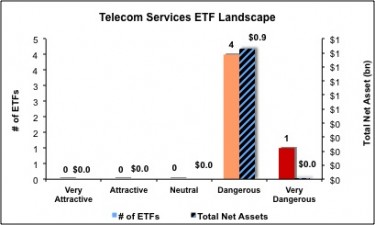 Sources: New Constructs, LLC and company filings
Sources: New Constructs, LLC and company filings
Figure 5: Separating the Best Mutual Funds From the Worst Mutual Funds
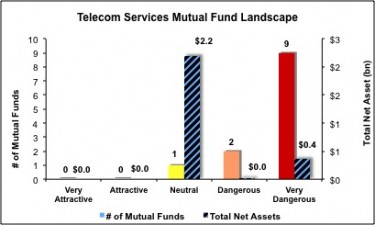 Sources: New Constructs, LLC and company filings
Sources: New Constructs, LLC and company filings
Review my full list of ratings and rankings along with free reports on all 5 ETFs and 12 mutual funds in the Telecom sector.
Disclosure: I receive no compensation to write about any specific stock, sector or theme.

